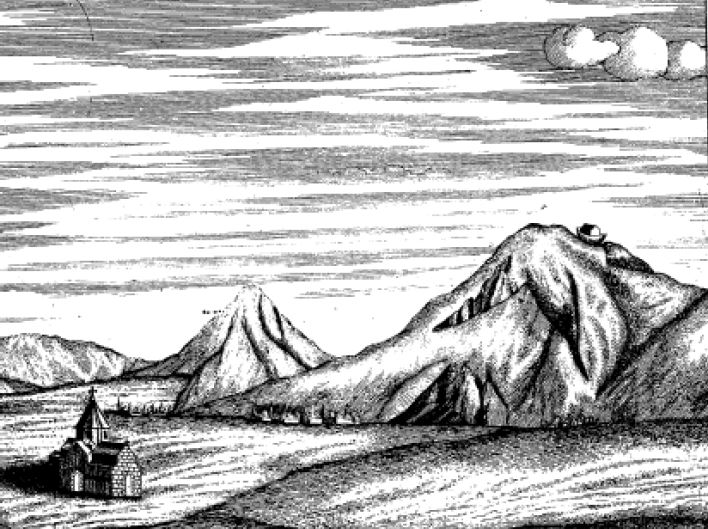Dawn discusses a passage from one of her favourite early modern travel accounts, which identifies mountains as sites of classical and Biblical memory.
It does not happen often, but every now and then, in the midst of piecing together a coherent narrative from dozens of disparate texts, a historian can chance across a centuries-old text which tells the whole story clearly in its own words.
I enjoyed just such a rare experience when trawling through seventeenth-century travel accounts during my PhD in an attempt to explore what motivated early modern British travellers to visit and even climb mountains. Something which was apparent to me, from the jigsaw of different sources to hand, was that travellers were often compelled to visit mountains as sites of myth and memory: as places where great events occurred, and where they could tread the same ground as a blessed saint or a famed leader. It was a moment of research delight, then, to discover the following passage, which articulated this very idea, and more:
What I pray you is more pleasant, more delectable, and more acceptable unto a man then to behold the heigth of hilles, as it were the very Atlantes themselves of heaven? to admire Hercules his pillers? to see the mountaines Taurus and Caucasus? to view the hill Olumpus, the seat of Jupiter? to passe over the Alpes that were broken by Annibals Vinegar? to climbe up the Apennine promontory of Italy? from the hill Ida to behold the rising of the Sunne before the Sunne appeares? to visite Pernassus and Helicon, the most celebrated seates of the Muses? Neither indeed is there any hill or hillocke, which doth not containe in it the most sweete memory of worthy matters: there shalt thou see the place where Noahs Arke stood after the deluge: there where God himselfe dwelt, and promulged his eternall law amongst the thunders and lightnings […] there the servant of the Lord [Moses] to have fedde his father in lawes sheepe, and to have seene the great Jehova in a burning bush […] there our Saviour to have ascended from the earth after his resurrection… [1]
This passage formed part of the prefatory materials to a 1611 volume entitled Coryats Crudities, an eccentric account of a journey through Europe written by an equally eccentric individual: Thomas Coryat (c.1577-1617), self-appointed ‘jester’ to the court of Prince Henry. However, for all that his travel account sometimes erred on the comedic (one of my favourite passages, entirely unrelated to mountains, sees Coryat carefully climbing down from the top of giant wine barrel, which he insists is a greater wonder than the Colossus of Rhodes), it also laid claim to the more serious trappings of the early modern genre of travel literature. One example of this is in Coryate’s translation, from which the above passage is taken, of ‘an oration made by Hermanus Kirchnerus… professor of Eloquence and Antiquities in the famous Universitie of Marburg’ on the advantages of foreign travel to the education of young men.
Mountains, therefore, are one of Kirchner’s justifications for travel, and to some extent simply because they are remarkable to look at: their height, the sun rising on their slopes. But mountains are important to visit for more than just their external forms: the memories, stories, and ideas which they belong to and which belong to them give them a moral value. What better way for a young traveller to develop spiritually than to stand on the very spot where the Ten Commandments were given and to reflect on God and His Laws? What better way to appreciate leadership than to experience the landscape through which Hannibal commanded his army?
One of the key themes of our Leverhulme project is how mountains functioned as sites of memory – from the ancient world onwards – and what is so compelling about this passage is the equation between a precise physical space, and a specific Biblical or classical memory. The sites alluded to possess no archaeological remnants of the remembered events, but to a classically-educated or Christian visitor, Hannibal was there, the Ark there, and to stand upon or look at the same supposed spot invokes a closer connection with such important past occurrences. The ‘sweete memory of worthy matters’, as Kirchner puts it, is literally contained within the landscape.
[1] For the translated passage, see Thomas Coryate, Coryat’s Crudities Hastily Gobbled Up in Five Moneths Trauells in France, Sauoy, Italy [etc.] (London, 1611), sig. C6. For the original, see Hermann Kirchner, De gravissimis aliquot cum juridicis tum politicis quaestionibus in utramque partem discussis, orationes (Frankfurt, 1599), pp.71-72.
Illustration. The image – with the memory of the Ark still visible on the summit of Mount Ararat, in an otherwise naturalistic sketch of the seventeenth-century landscape – is from John Chardin, The Travels of Sir John Chardin into Persia and the East-Indies (London: printed for Moses Pitt, 1686), plate 9, facing p. 248.

